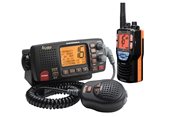Flow rate
The range of these devices is optical (see term VHF), which means that communication between two antennas is generally possible, when the two antennas "see" each other. In fact, small obstacles, but also the earth's curvature, can interfere with the propagation of these radio waves.
The range within which the earth's curvature should not interfere is fixed at 12 miles; to overcome this obstacle, the antenna will therefore have to be installed in the highest possible position, which is also why the ground coastguard stations are installed in a high position, which makes them sometimes reachable even at a distance of 30 miles.
Obviously also the power plays an important role in the possibility of crossing over obstacles, in fact with greater power we will have more chance that the signal turns the obstacle or that you benefit from possible refractions (of the ionosphere or physical objects placed along the path of the radio wave).
But there are countless aspects related to the assessment of the scope, so much so that it can not be precisely defined, for example, in some cases it was possible to establish a communication of several hundred miles, but these are occasional episodes, sometimes in conjunction with intense solar activities.
Not being able to count on these occasional episodes, we give a series of tips so that the marine VHF on board fixed type is better efficient and can thus count on the maximum range achievable:
- Move the antenna as high as possible. In the case of a sailboat, install the antenna at the masthead, otherwise mount it on the highest deck or on the rollbar.
- Choose an antenna with a good gain (6 dB) and long, but not exceeding 2.5 m, because the longer antennas are more delicate especially if they consist of 2 elements.
- Choose an antenna that is specifically calibrated for the marine VHF frequency.
- Use a good quality cable and especially avoid conjunctions or folds of the cable, because they cause leaks.
- Route the cable away from sources of interference, which may be caused by other cables, equipment or metal masses.
- Use a cable length that does not exceed the installation requirements (the longer the cable, the greater the dispersion).
- Maintain efficient power supply system, a fixed apparatus can absorb even 6 A., if the apparatus does not have the ability to be served by sufficient power supply, will transmit at a lower power.
Fixed or portable?
For pleasure craft, the regulations do not make a distinction, although it is reported that some authorities have required in the verifications the fixed for boats allowed to navigate beyond 12 miles.
Generally it is suggested that both the fixed and the handset be equipped (both must be declared in the application for the RTF License). The fixed allows for greater safety thanks to its wider range. While the laptop, preferably floating type, allows its use even when the batteries of the boat are damaged and to be able to transfer it to the life raft.
